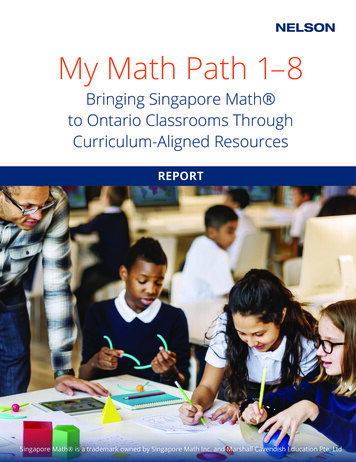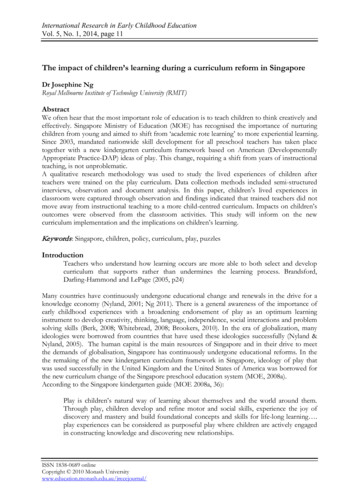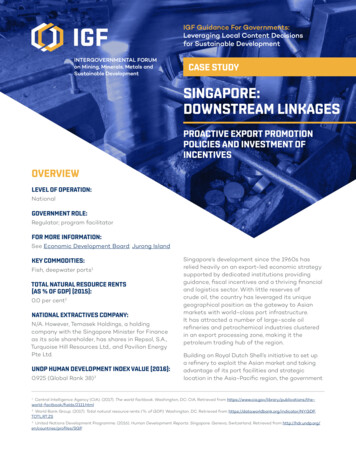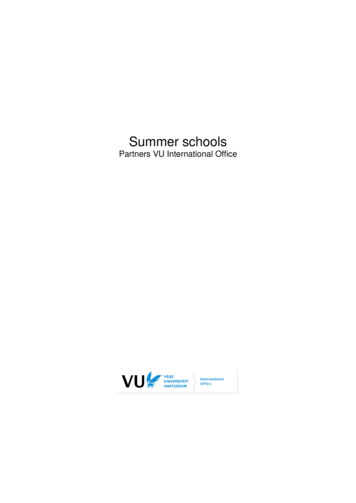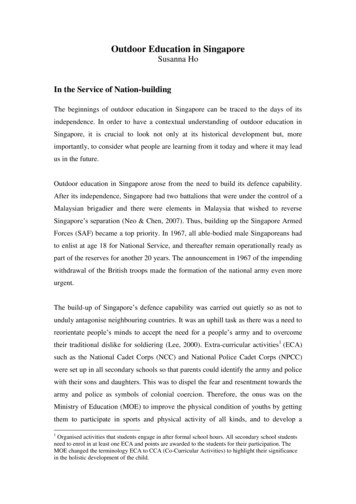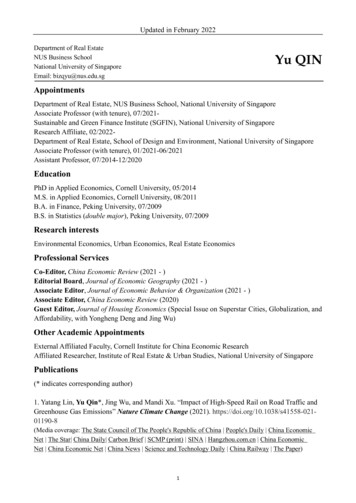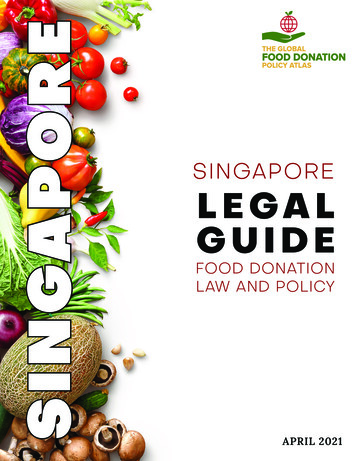
Transcription
SINGAPORESINGAPORELEGALGUIDEFOOD DONATIONLAW AND POLICYAPRIL 2021
AuthorsThis report was written by the following staff and students at the Harvard Law School Food Law and PolicyClinic (FLPC): Ariel Ardura, Regan Plekenpol, and Emily M. Broad Leib.AcknowledgementsWe are grateful to The Global FoodBanking Network (GFN) whose input, ideas, and expertise informed muchof our research. This report was also made possible by the advice and support of our on-site partners inGuatemala, with whom we discussed the ideas provided here, including Singapore Food Bank and QuaheWoo and Palmer LLC, and many other NGOs, businesses, and government agencies.About The Global Food Donation Policy AtlasThe Global Food Donation Policy Atlas is a first-of-its-kind initiative to promote better laws on food donationto help address food loss and food insecurity. This project maps the laws affecting food donation in countriesacross the globe in order to help practitioners understand national laws relating to food donation, comparelaws across countries and regions, analyze legal questions and barriers to donation, and share best practicesand recommendations for overcoming these barriers. The project is a collaboration between Harvard LawSchool Food Law and Policy Clinic and The Global FoodBanking Network. To learn about and compare thefood donation laws and policies for the countries FLPC has researched to date, visit atlas.foodbanking.org.About the Harvard Law School Food Law and Policy ClinicFLPC serves partner organizations and communities by providing guidance on cutting-edge food systemlegal and policy issues, while engaging law students in the practice of food law and policy. FLPC focuses onincreasing access to healthy foods; supporting sustainable food production and food systems; and reducingwaste of healthy, wholesome food. For more information, visit www.chlpi.org/FLPC.About The Global FoodBanking NetworkGFN is an international non-profit organization that nourishes the world’s hungry through uniting and advancingfood banks in more than 40 countries. GFN focuses on combating hunger and preventing food waste byproviding expertise, directing resources, sharing knowledge and developing connections that increaseefficiency, ensure food safety, and help food banks reach more people facing hunger. For more informationvisit www.foodbanking.org.Made Possible with Support from the Walmart FoundationThe research included in this report was made possible through funding by the Walmart Foundation. Thefindings, conclusions, and recommendations presented in this report are those of Harvard Law School FoodLaw and Policy Clinic alone, and do not necessarily reflect the opinions of the Walmart Foundation.Report design by Najeema Holas-Huggins.
TABLE OF CONTENTSIntroduction.1Purpose of this Guide.1State of Food Insecurity, Food Loss, Waste, and Recovery in Singapore.2Overview of Singapore’s Food Donation Legal Framework.4National Food Laws.4Sale of Food Act.4Singapore Food Agency Act.5Other Relevant National Law.5Legal Issues Relevant to Food Donation.5Food Safety for Donations.5Date Labeling.6Liability Protection for Food Donations.7Civil Liability: Tort.8Civil Liability: Contract.8Criminal Liability Under the Singapore Penal Code.8Taxes.8Incentives.9Barriers.9Donation Requirements or Food Waste Penalties.10Government Grants and Incentives.10Conclusion.11PAGE i
INTRODUCTIONPurpose of this GuideFood loss and waste is one of the greatest food system challenges that we face today. An estimated one-third offood produced globally is ultimately lost or wasted along the supply chain;1 this amounts to approximately 1.3billion tons of food each year that ends up in the landfill.2 Food loss or waste occurs at every stage of the foodsystem: during the initial harvest due to low market prices, because of high labor costs and demand for perfectlooking produce; by grocery stores and restaurants overestimating customer demands; and by consumers whoengage in inefficient shopping and cooking practices and lack a clear understanding about date labels.3These behaviors have significant environmental, economic, and social consequences: food that is ultimatelylost or wasted has a huge carbon footprint of 3.3 gigatons,4 using roughly 28% of agricultural land5 andaccounting for 8%, or 70 billion tons, of total global greenhouse gas emissions.6 Collectively, this damage costsapproximately US 940 billion per year.7 Meanwhile, more than 820 million people are undernourished andone in nine is food insecure.8 The international community has sought to address this paradox and mobilize thereduction of food waste, especially within the framework of the 2030 Agenda for Sustainable Development andSustainable Development Goal 12.3.9In many countries, food donation has emerged as a popular and logical solution to redirect safe, surplus fooddestined for landfills into the hands of those who need it most. Most food donations are facilitated through foodbanks or other charitable, nongovernmental organizations that recover surplus, wholesome food and redirectit to local beneficiary agencies (such as soup kitchens, shelters, and community pantries) to feed low-income,food-insecure persons. As food insecurity, food loss, and food waste continue to rise, new, innovative models offood recovery have emerged around the world.However, uncertainty surrounds the laws and regulations most relevant to food donation. To help addressthe most pressing questions, the Harvard Law School Food Law and Policy Clinic (FLPC) and The GlobalFoodBanking Network (GFN) have partnered to create The Global Food Donation Policy Atlas.10 This innovativepartnership maps the laws and policies affecting donations in 14 countries over the course of two years. Theproject aims to identify and explain national laws relating to food donation, analyze the most common legalbarriers to promoting greater food donation, and share best practices and recommendations for overcomingthese barriers.THE PROJECT AIMS TO IDENTIFY AND EXPLAIN NATIONAL LAWS RELATING TOFOOD DONATION, ANALYZE THE MOST COMMON LEGAL BARRIERS TO PROMOTINGGREATER FOOD DONATION, AND SHARE BEST PRACTICES AND RECOMMENDATIONSFOR OVERCOMING THESE BARRIERS.This Legal Guide focuses on Singapore, where the amount of food wasted has increased by 20% over the past10 years. In 2019, 744,000 tons of food waste was generated.11 FLPC and GFN, in collaboration with partners inSingapore,12 developed this resource to help food donors, food banks, and other intermediaries (hereinaftercollectively referred to as “food recovery organizations”) understand the relevant legal frameworks that impactfood waste and donation efforts. This Legal Guide also serves as a resource for those in other countries that arelooking to inform their own food donation laws and policies.After providing initial commentary on food loss and recovery in Singapore, this Legal Guide provides anoverview of the legal frameworks most relevant to food donation at the national and local levels. The subsequentsections look closely at the laws generally applicable to food donation: food safety laws and regulations, fooddate labeling laws, “Good Samaritan” or liability protection laws, tax incentives for food donation and/or taxPAGE 1
policy disincentives, and waste diversion laws that penalize food waste or require recovery. The extent to whichSingapore has developed and subsequently implemented these legal frameworks compared to other countriesmay vary.State of Food Insecurity, Food Loss, Waste, andRecovery in SingaporeSingapore residents enjoy a relatively affordable supply of readily available food. In the 2019 edition of theEconomist Intelligence Unit’s Global Food Security Index, which was published prior to the COVID-19 pandemic,Singapore ranked first as the most food-secure nation in the world.13 It excelled in the categories of “affordability,”“availability,” and “quality and safety of food,” ranking 2nd, 2nd, and 25th respectively.14 Singapore achieved thisstandard of security despite more than 90% of its food being imported.15Only around two square kilometers (200ha) of land was used for land-based food farms in 2019, occupyingless than 1% of Singapore’s total land area.16 Due to the import-reliant nature of Singapore’s food supply,diversification is a major priority. Singapore sources food from more than 170 countries, which totaled S 15.57billion (US 10.9 billion) of imports in 2014.17To ensure and secure the future supply of food in Singapore, the Singapore Food Agency (SFA) uses threemain strategies: (1) diversify import sources, (2) grow local, and (3) grow overseas. The second strategy worksin conjunction with SFA’s ambitious goal of meeting 30% of Singapore’s nutritional needs with local produceby year 2030 through giving S 30 million in grants to local producers.18 Over the past five years, S 38 millionfrom the Agriculture Productivity Fund has been committed to support about 100 farms in their efforts to raiseproductivity and build resilience against climate change.19 Another S 144 million from the National ResearchFoundation has been committed to fund agrifood research.20 Singapore recently released a new packaging sealto help consumers identify local produce to support local farms.21The average Singapore household has a relatively high gross domestic product (GDP) per capita (US 64,581.94in 2018). With no tariffs on food, food expenditures are a relatively small part of household budgets—less than10% by government statistics.22 This compares with neighboring countries in which household expenditures onfood are between 30% and 45% of household incomes.23 Despite the relative affordability of food in Singapore,reports suggest that approximately 1 in 10 Singaporeans experience food insecurity.24 While Singapore’s grossdomestic output outranks that of developed economies like Germany and the United States in some measures,the wealth gap is among the widest in advanced economies in Asia after Hong Kong.25 Singapore’s welfaresystem is housed under the Ministry of Social and Family Development and covers childhood education,transportation subsidies for disabled individuals, and medical care assistance for elderly citizens. Whileprograms such as ComCare distribute funds for those in need, Singapore does not have a specific governmentalfood assistance program.26FOOD WASTE IS ONE OF THE BIGGEST WASTE STREAMS IN SINGAPORE, AND THEAMOUNT OF FOOD WASTE GENERATED HAS GROWN BY AROUND 20% OVER THELAST 10 YEARS.At the same time, food loss and waste represent major social challenges in Singapore. According to the NationalEnvironment Agency (NEA), food waste is one of the biggest waste streams in Singapore, and the amount offood waste generated has grown by around 20% over the last 10 years.27 In 2019 Singapore generated around744 million kilograms of food waste. That is equivalent to two bowls of rice per person per day for the entireyear or the size of about 51,000 double-decker buses.28 Food waste makes up roughly half of the average 1.5kilograms of waste generated by each household in Singapore every day.29 A study conducted by Singapore’sEnvironment Council in partnership with Deloitte found that much of this food loss (393,000 tons) is happeningPAGE 2
“upstream” (production) and “midstream” (processing and transportation) due to “poor disease and pestmanagement; over importation of food items; cosmetic standards; fragmented cold chain management; andinadequate infrastructure,” among other drivers.30 Importantly, the study specifically notes that the lack of“provision that protects entities from liabilities when they donate food to charity” as one of the key midstreamdrivers and recommends introducing “policies to safeguard entities from liabilities.”31 Further, the study notesdrivers of “downstream” waste, which include confusion around expiry date labels among consumers, lack ofpenalty for improper disposal, and “limited policies to encourage redistribution.”32 The study proposes thatadopting clearer definitions or adjusting the labeling scheme, introducing policies to discourage food wastedisposal and incineration, and facilitating increased donation of unsold foods (e.g., from hotels, restaurants,and cafeterias) will be effective mitigators of food loss and waste in Singapore.33Singapore by the NumbersPopulation5,703,569Global Hunger IndexNot measuredWorld Bank ClassificationHigh incomeMedian Age42.2 yearsGlobal Food Security Index87.4Human Development Index0.938GDPUS 372.1 billionGINI IndexNot measuredFLW Estimates763,000 tonsPoverty Rate10%Food Sustainability IndexNot measuredSource: The Global FoodBanking Network, Dec. 2020The Singapore government strongly emphasizes reducing food loss and waste as part of its dedication tonational food security and overall sustainability initiative. Guidance from the official “Towards Zero Waste”government campaign outlines Singapore’s goal to reduce the amount of waste (per capita) sent to landfills30% by 2030 on top of an existing target to achieve a 70% overall recycling rate by 2030.34 The government isfocused on reaching this goal by trimming the percentage of food spoiled and by recycling the by-products. Forexample, the Singapore government enacted the Resource Sustainability Act in 2019 to address food waste bymandating that large commercial and industrial food waste generators develop the infrastructure for on-sitewaste treatment.35 To date, the focus has been more on food waste treatment and repurposing than on usingfood donation as a strategy to keep safe, edible food in the food stream to alleviate food insecurity in Singapore.THE SINGAPORE GOVERNMENT STRONGLY EMPHASIZES REDUCING FOOD LOSS ANDWASTE AS PART OF ITS DEDICATION TO NATIONAL FOOD SECURITY AND OVERALLSUSTAINABILITY INITIATIVE. HOWEVER, TO DATE, THE FOCUS HAS BEEN MORE ONFOOD WASTE TREATMENT AND REPURPOSING THAN ON USING FOOD DONATION ASA STRATEGY TO KEEP SAFE, EDIBLE FOOD IN THE FOOD STREAM TO ALLEVIATE FOODINSECURITY IN SINGAPORE.Scaling up current agency operations to divert food waste and investing in new solutions to hunger and foodwaste require recognizing and understanding the laws that apply to food donation. The remaining sections ofthis Legal Guide provide an overview of Singapore’s food donation legal framework and address the issues mostlikely to arise for food donors, food recovery organizations, policymakers, and other interested stakeholders.PAGE 3
OVERVIEW OF SINGAPORE’S FOODDONATION LEGAL FRAMEWORKA former British colony, Singapore gained independence in 1965, and its legal system is based on Englishcommon law.36 The constitution comprises the fundamental principles and basic framework for the three organsof state: (1) the executive, which consists of the president, prime minister, and other ministers responsible forgovernment affairs and accountable to the Singaporean Parliament; (2) the legislature, which consists of thepresident and Parliament with its legislative authority responsible for enacting legislation; and (3) the judiciary,which comprises the various courts of law that operate independently of the executive and legislature.37 As asmall island nation, all power of law is central to the national government.Major areas of law such as contract and tort law are judge-made common law. However, other areas of law (e.g.,property, criminal, company, and family law) are governed primarily by statutes.38 Singapore’s law is foundedon four pillars: constitution, legislation, subsidiary legislation, and legal decisions made by judges.39 Subsidiarylegislation, or subordinate legislation, consists of written laws made by ministers or other administrativeagencies such as government departments and statutory boards under the authority of a statute (called the“parent” act or statute), not directly by Parliament.40 Otherwise, legislation, or statutory laws, are enacted bythe Parliament.41The Singaporean Parliament is unicameral. It comprises 93 elected members (MPs) as well as two appointednonconstituency members (NCMPs) and nine nominated members (NMPs).42National Food LawsSale of Food ActThe Sale of Food Act (SOFA) was first enacted in 1973 and most recently revised in 2005.43 This Act is theprimary food legislation in Singapore. It regulates food for sale to ensure it is safe and suitable for humanconsumption and to promote public health. It also mandates the provision of “information relating to foodto enable consumers to make informed choices and [to prevent] misleading conduct in connection with thesale of food.”44 SOFA governs national food safety, manufacturing, processing, distribution, sale, and import/export. It also mandates the licensing of nonretail food businesses (such as manufacturing or processingplants)45 by the Director General under Part IV. SOFA contains provisions prohibiting the adulterationof foods; restricting the use of food additives or processing aids; prohibiting misleading or deceptiveadvertising, labeling, and unfair trade practices; and prohibiting the import, advertising, or sale of food thatis substandard, unsafe, or misbranded. In particular, because Singapore is an import-reliant nation, importedfood is also subject to requirements to ensure the food is safe and suitable for human consumption and tosupport a secure and reliable supply of imported food in Singapore. Requirements include keeping recordsof the source, traceability, and handling of imported food.46 Noncompliance with or violation of the food safetyprovisions within SOFA may lead to monetary penalties not exceeding S 10,000, to imprisonment for a termnot exceeding 12 months, or both.47THE SALE OF FOOD ACT REGULATES FOOD FOR SALE TO ENSURE IT IS SAFE ANDSUITABLE FOR HUMAN CONSUMPTION AND TO PROMOTE PUBLIC HEALTH.SOFA applies to those holding a food business license, proprietors of food businesses or food premises,manufacturers, importers, exporters, or persons in the business of selling or supplying (wholesale or retail)any food or food contact article.48 Under Section 2B(1), SOFA defines “food business” to include food production,PAGE 4
sale, or handling “regardless of whether the business, undertaking or activity concerned is of a commercial,charitable or community nature.”49 Under Section 2E(3)(b), SOFA states when defining the meaning of “sell”that “food that is donated for a charitable or benevolent purpose is not to be taken to be food that was given awayfor the purpose of advertisement or in furtherance of trade or business.”50 As such, charitable food donationis considered “food business” but donated food is not considered under the definition of “sell.” SOFA does notinclude any further specific provisions for donated foods.The Food Regulations, promulgated under SOFA, regulate food labeling requirements, nutrition panels,acceptable claims and marketing, date marking, and registration of imported foods.51 In addition, the FoodRegulations govern food additives and permissible levels of contamination in food.52 The Singapore FoodAgency (SFA) is responsible for enforcing the Food Regulations under SOFA.Singapore Food Agency ActThe Singapore Food Agency Act of 2019 formed SFA to consolidate all food-related functions, then carriedout by the Agri-Food and Veterinary Authority of Singapore (AVA), National Environment Agency (NEA), andthe Health Sciences Authority (HSA).53 Prior to the creation of SFA, NEA produced much of the governmentguidance on food waste and donation. SFA supports the regulation and production of all food in Singapore,from produce to animal feed, to ensure a safe food supply that promotes public health and keeps consumersadequately informed. This mandate to minimize food safety risks includes monitoring the processing andhandling of food across the supply chain and regulating hygiene and operating procedures of premises,vehicles, and equipment used for handling and supplying food.54 SFA also regulates street hawking, tradefairs, fisheries, agribiotechnology, agrotechnology, and food biotechnology.55 Education initiatives, personneltraining, and public information campaigns are also in SFA’s purview, with the aim to increase public andindustry awareness of food supply resilience, food safety, food standards, and food labels across all foodverticals. SFA also covers food import, requiring that all foods imported into Singapore comply with Singapore’sfood standards.56In addition, SFA advises the government on matters relating to the food industry;57 represents thegovernment internationally on matters relating to fisheries, food businesses, food safety, or food supply;58collects, compiles, and analyzes data about food and publishes those results;59 and promotes and undertakesnew research.60Other Relevant National LawOther important legislation includes (1) the Singapore Penal Code, which houses Singapore’s substantivecriminal law;61 (2) the Consumer Protection (Fair Trading) Act under the Competition and Consumer CommissionSingapore (CCS),62 which protects consumers against unfair practices and gives them additional rights inrespect to goods that do not conform to contract; and (3) the Income Tax Act,63 which sets out the structurefor income taxes in Singapore.LEGAL ISSUES RELEVANT TO FOODDONATIONFood Safety for DonationsIn many countries, a key barrier to the donation of surplus food is the lack of knowledge or readily availableguidance regarding safety procedures for food donation. All donated food should be safe for consumptionPAGE 5
and comply with applicable food safety laws and regulations. Potential donors, however, are often uncertainabout which food safety regulations apply to donated food as opposed to purchased food and about the stepsnecessary to safely donate food in compliance with applicable regulations. As a result, safe, surplus food thatcould have been redirected to populations in need is instead sent to landfills.As previously discussed, in Singapore the Sale of Food Act is the statute that lays out all national food safetystandards and is applicable to any entity that is a licensee of a food business, proprietor of a food business orfood premises, manufacturer, importer, exporter, or person in the business of selling or supplying (wholesaleor retail) any food or food contact article. SFA is responsible for setting additional rules and standards underSOFA and enforcing the act. Under SOFA, SFA issued the Food Regulations, which seek to ensure that foodimported and sold is safe and suitable for human consumption; to promote public health; and to prevent thesale of food that is unsafe, adulterated, or has misleading information.64Charitable organizations supplying food without profiting are also regulated under SOFA because the actexplicitly applies to the supply of food without monetary consideration. Under SOFA, the definition of “sell”includes: (a) the supplying of food, whether or not for consideration, in the course of providing services topatients, children, or individuals in the care and custody of the supplier and prisoners or inmates;65 (b) thesupplying of anything of which food forms a part;66 and (c) bartering.67 SOFA further clarifies that “food business”can include businesses, undertakings, or activities of a charitable or community nature.68 Conversations withstakeholders also suggest that SOFA should be interpreted as applying to donated food.However, no written law sets out any specific or differentiated requirements or regulations that apply tofood donation. Nevertheless, the Singapore government issued guidance on food safety for food donations in2016 titled “Guidelines on Food Donation” under NEA to clarify food safety standards for the procurement,processing, and distribution of donated food.69 The Guidelines state that provisions must be adhered to bynongovernmental organizations, food and beverage retail establishments, and food manufactures that are: (a)donating/collecting and redistributing prepackaged and perishable food items, (b) preparing and cooking food,and/or (c) transporting donated food to recipients. The Guidelines also state that food banks or food recoveryorganizations should not accept donated food after the expiration date and should have specific food safetyinstructions on when to discard food.70 SFA has overseen food safety since its advent in 2019. Accordingly, SFAmay reissue updated Guidelines or further guidance in the near future.The Guidelines on Food Donation outline the responsibilities of donors and food recovery organizations.Donors must ensure that donated food is in good condition and properly labeled. They must inform recipientsof the measures they should take to ensure the food is safe for consumption.71 Additionally, donors mustensure the donated food is held at safe food temperatures and transported within the shortest amount of timepossible. Food recovery organizations that receive the donated food are responsible for checking the conditionof the food upon receipt and should request information on the safety measures required to ensure safeconsumption if that information is not available.72 The Guidelines do not specifically address penalties if thedonor or recipient is noncompliant. However, they do state that the Guidelines are intended to assist actorsin complying with the law set forth by the Food Regulations.73 Individual food recovery organizations mayimplement the Guidelines from NEA as they see fit in their internal operations. Yet there does not appear to beany data on which organizations are following the Guidelines and to what extent.Date LabelingDate labels affixed to food products are a major driver of food waste and an obstacle to food donation. Asexplained in the previous section, most food donors and food recovery organizations are appropriately cautiousabout donating food that meets safety standards, but it is not always clear which standards relate to food safety.And, while fresh products like fruits and vegetables will appear visibly spoiled when they are no longer safeto consume, it can be more difficult to gauge when this is the case for packaged foods. Many donors interpretdate labels affixed to such food products as indicators of safety and will therefore throw away food once thePAGE 6
“expiration date” has passed; intermediaries may refuse to accept donated food after this date, deeming thefood product unfit for human consumption.Despite this interpretation, for the vast majority of foods, date labels indicate freshness or quality rather thanfood safety. Manufacturers use a variety of quality-based methods to determine the time frame for label dates,all of which are intended to reflect when the food will be at its “peak quality.”74 Nevertheless, global trendsindicate that consumers generally confuse date labels as indicator
system is housed under the Ministry of Social and Family Development and covers childhood education, transportation subsidies for disabled individuals, and medical care assistance for elderly citizens. While programs such as ComCare distribute funds for those in need, Singapore does not have a specific governmental food assistance program.26





